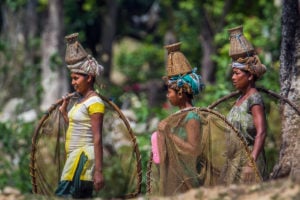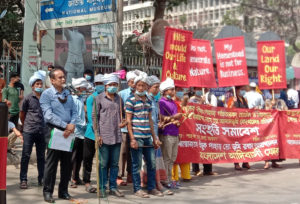On 12 July 2021, a district court in Nepal convicted a Nepali Army sergeant for his involvement in the death of 24-year-old Raj Kumar Chepang in July 2020. The court sentenced the soldier to nine months’ imprisonment and a fine of 9,000 Nepali rupees (about USD 80). It also ordered him to pay NPR 200,000 (about USD 1,700) in compensation to the family of the victim, who was from the indigenous Chepang community. Nine months having already elapsed since the sergeant’s detainment, he was released on the passing of the sentence.
This is probably the first case of an army personnel facing a criminal charge under the Penal Code 2017, which criminalised acts of torture for the first time in the country.
The judgement shows that the soldier was charged under Section 182 (3) of the Penal Code (death by negligence), based on the testimony given to the court by an eyewitness who accompanied Raj Kumar to collect snails in Chitwan National Park. The testimony given in the court read that Raj Kumar and the witness were not beaten, but only “scolded” by the soldier.
This is quite different from what Santosh Chepang, who also accompanied Raj Kumar that day with six others, told us during our visit to the Chitwan area. He said: “We were collecting ghungi (snails) in a rivulet in the park when a Nepali Army personnel found us… For 20-25 minutes, he beat all of us except the two women. When the women asked the soldier not to beat us, he verbally abused them. Then, we were asked to carry wooden logs until we reached the park administration. We were beaten up again on the way. When we tried to speak, the soldier did not let us speak.”
He added that the park administration took their photos and registered their names. “In the beginning, the officials asked us to pay NPR 1,000 per person as a fine, but we pleaded with them as we did not have much money. We agreed to pay NPR 500 per person. While returning home, Raj Kumar was not able to walk properly. We helped him. His condition deteriorated, and [he] passed away a few days later.”
Government attorney Mahesh Khatri, who pleaded the case on behalf of Raj Kumar’s family, was not satisfied with the court’s July 2021 decision. Khatri filed an appeal before the Patan High Court in August 2021, seeking a stronger sentence. It remains to be seen how the high court will respond to the district court’s lenient sentence.
One of many instances of human rights violations
Raj Kumar’s case is just one of many human rights violations and abuses experienced by indigenous communities at the hands of the security forces and park authorities in Nepal on a regular basis.
On 9 August, International Day of the World’s Indigenous Peoples, Amnesty International and Community Self-Reliance Centre jointly published a report, ‘Violations in the name of conservation: What crime had I committed by putting my feet on the land that I own?’ The report documents incidents of human rights violations faced by indigenous people who reside in the vicinity of Nepal’s protected areas, including arbitrary arrests, illegal detention, torture, unlawful killing and forced evictions.
The report, based on evidence gathered from two national parks – Chitwan National Park and Bardia National Park – records how the establishment of the national parks and other “protected areas” has resulted in tens of thousands of indigenous people being forcibly evicted from their ancestral lands and denied access to areas they depend on for subsistence. The study also highlights how the enforcement of abusive conservation laws and policies has frequently led to a litany of human rights violations.
Research into co-managed and community-owned conservation areas shows that they have on average more success in achieving conservation outcomes
Such violations increased substantially after the 1970s, when Nepal adopted far-reaching conservation laws and policies. These have been used to force indigenous people off their ancestral lands and severely limit their ability to access traditional foods, medicinal plants and other resources. This is despite research (by indigenous peoples, local communities and conservation experts) into co-managed and community-owned conservation areas showing that they have on average more success in achieving conservation outcomes than protected areas that are exclusively state-run.
Conservation success and indigenous rights go hand-in-hand
Nepal’s wildlife conservation efforts are lauded as a success story worldwide, and numbers of endangered one-horned rhinoceros, tiger, Asiatic elephant and gaur have undoubtedly increased. But this has come at a high price for indigenous people.
Evidence also suggests that such gains could have been achieved, if not bettered, if indigenous people had been included as genuine partners in the conservation efforts. The participation of local indigenous people, with their traditional knowledge on the management of natural resources, should be key to state-led conservation initiatives, to both ensure a sense of local ownership and to incorporate their expertise in fostering conservation options that will serve their interests and promote opportunities for better livelihoods.
Forced eviction is not the answer, and neither are other violations of indigenous peoples’ rights. To address the longstanding damage done by forced evictions, the authorities must hold consultations with indigenous people to find a remedy. The option of returning to their ancestral lands in the national parks must not be ruled out unless the government can demonstrate compelling reasons of national interest that mean this is not possible, backed up with concrete evidence. This would be in line with the rights set out in the United Nations Declaration on the Rights of Indigenous Peoples. For many indigenous peoples, the return of their lands is paramount. In cases where this is not possible, compensation must reflect the value of the land they have lost.
Many people who lost their homes and lands due to the establishment of national parks and other protection areas cannot or choose not to return to their ancestral lands. They should be provided with alternative housing and land that guarantees an adequate standard of living and sustainable livelihoods without distorting their traditional ways of life.
On top of that, the government must amend the legal framework governing the country’s conservation efforts, including the National Parks and Wildlife Conservation Act, through a consultative process with indigenous people.
Ensuring indigenous people lead dignified lives and can meaningfully participate in conservation efforts can only help to sustain conservation in the true sense of the word.
Note: Both the authors were involved in carrying out the research behind the report “Violations in the name of conservation”.








